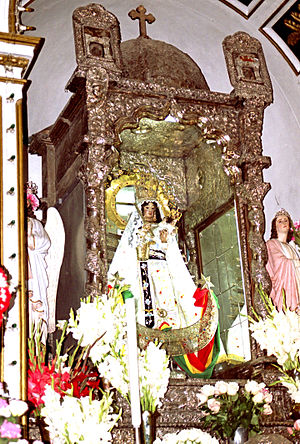Virgen de Copacabana
| Virgen de Copacabana | |
|---|---|

Original statue of the Virgen de Copacabana in the Basilica
|
|
| Our Lady of Copacabana Most Blessed Virgin of the Candelaria Queen and Patroness of Bolivia La Coyeta |
|
| Venerated in | Roman Catholic Church (Bolivia) |
| Major shrine | Basilica of Our Lady of Copacabana, Copacabana, Bolivia |
| Feast | 2 February 5 August |
| Attributes | Blessed Virgin Mary, Inca dress and crown, Infant Jesus, straw basket, pigeons, baton, gold Quechua jewelry |
| Patronage | Bolivia and Bolivian people, Bolivian Navy, National Police of Bolivia |
The Virgen de Copacabana (literal translation: Virgin of Copacabana; figurative translation: Our Lady of Copacabana; variant: Blessed Virgin of the Candelaria, Our Lady of Copacabana) is the patron saint of Bolivia. She is venerated in Bolivia during her feast day of 2 February, the day of the Purification of Mary, or feast of the Virgen de la Candelaria. She is also venerated on 5 August with her own liturgy and popular celebration.
Copacabana is a Bolivian town located on a peninsula at the southeastern shore of Lake Titicaca. It is close to Isla del Sol and Isla de la Luna, islands sacred to the Aymara and Quechua. In the mid 16th century, the inhabitants of Copacabana were divided into two groups: Anansayas, Inca newcomers, and Urinsayas, the traditional residents of the region. Despite conversion to Christianity, they continued an attachment to their original religion. Poor harvests lead them to consider attracting favor from heaven through a new confraternity. The Anansayas resolved to venerate the Virgin Mary while the Urinsayas selected San Sebastian.
Francisco Tito Yupanqui, an amateur sculptor, a descendant of the Inca Huayna Capac, and a member of the Anansayas, did not abandon the idea. He decided to create an image of the Madonna, believing it would influence the local people. Using clay, and assisted by his brother Philip, Francisco Tito created the image of the Virgin. The sculpture was placed at the side of the altar by the pastor, Father Antonio de Almedio. After Father Antonio left Copacabana, the priest Don Antonio Montoro took over. Unhappy with the look of the coarse and disproportionate sculpture, he ordered that it be removed from the altar and be placed in a corner of the sacristy.
Francisco Tito was humbled by this setback. Advised by relatives, he went to Potosi which had outstanding teachers of sacred image sculpting. While studying in the workshop of Maestro Diego Ortiz, Francisco Tito gained expertise in sculpture and in wood carving. With this skill, he resolved to create an improved image of the Candelaria. He looked through the churches of Potosí for an image of the Virgin which could serve as a model, finally finding the best one in the Convent of Santo Domingo to the Virgen del Rosario. He studied it closely to remember it before starting his new piece and held a Mass in honor of the Holy Trinity as a divine blessing for his work.
...
Wikipedia
